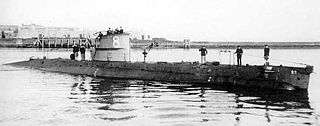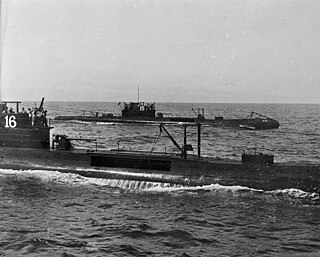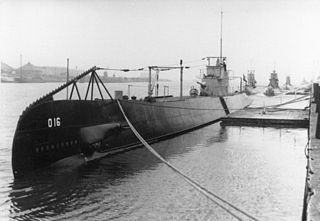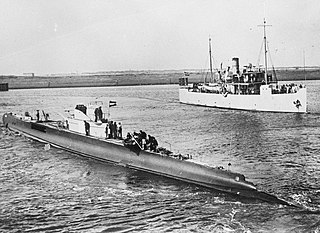
HMS H6 was a British H-class submarine of the Royal Navy built by Canadian Vickers & Co. during World War I.

O 19, laid down as K XIX, was an O 19-class submarine of the Royal Netherlands Navy that saw service during World War II. O 19, along with her sister ship O 20, were the first submarines in the world to be equipped with a submarine snorkel that allowed the submarine to run its diesel engines while submerged.

HNLMS Marten Harpertszoon Tromp was a unique coastal defence ship of the Royal Netherlands Navy built by the Rijkswerf in Amsterdam.
The O 9-class submarine consisted of three submarines, built for the Royal Netherlands Navy. Used for patrols in the Dutch home waters. The class comprised O 9, O 10, and O 11. Its diving depth was 60 metres (200 ft).

The O 21 class was a class of seven submarines, built for the Royal Netherlands Navy. The boats were still incomplete at the start of the German invasion of the Netherlands, O 21, O 22, O 23 and O 24 were hastily launched and escaped to the United Kingdom. O 25, O 26 and O 27 were not able to escape and were captured by the German forces. The Kriegsmarine ordered the completion of the boats and they entered German service as UD-3, UD-4 and UD-5. The submarines' diving depth was 100 meters (330 ft).

The K XIV class submarine was a class of five submarines, built for the Royal Netherlands Navy. Used for patrols in the Dutch colonial waters. The class comprised K XIV, K XV, K XVI, K XVII and K XVIII. The submarines diving depth was 80 m (260 ft). Three of the boats were lost in World War II.
HNLMS K XI was the first of three K XI-class submarines of the Royal Netherlands Navy, built to serve as a patrol vessel in the Dutch colonies.

HNLMS O 16 was a submarine of the Royal Netherlands Navy that saw service during World War II. She was the first submarine of the RNN manufactured from high-quality Steel 52, with the ability to dive at a depth of 80 metres (260 ft).

O 24, laid down K XXIV was an O 21-class submarine of the Royal Netherlands Navy that saw service during World War II. The most famous occupant of O-24 was Piet de Jong, who was the commanding officer from 1944 until 1946 and who later became Minister of Defence in 1963 and served as Prime Minister of the Netherlands from 1967 until 1971.

HNLMS O 12 was a O 12-class submarine of the Royal Netherlands Navy. Built at Koninklijke Maatschappij De Schelde in Vlissingen, she was launched in 1930 but was unable to take part in military action during World War II. After being scuttled by the Dutch Navy, she was raised by Nazi Germany's Kriegsmarine and taken into service as UD-2, and then scuttled again.

O 13 was an O 12-class submarine of the Royal Netherlands Navy that saw service during World War II. She was built by the Koninklijke Maatschappij De Schelde of Vlissingen. She was one of many Dutch ships doing convoy duty during the Spanish Civil War. At the time of the German invasion of the Netherlands, O 13 was on patrol off the Dutch coast and was attacked by German planes on multiple occasions. After fleeing to England, the submarine was lost during a patrol on the North Sea.
HNLMS O 7 was a unique patrol submarine of the Royal Netherlands Navy for use in the home waters of Europe. The ship was built by the Maatschappij Fijenoord shipyard in Rotterdam. The submarines diving depth was 40 metres. O 6 was very similar to the O 7 and they are sometimes regarded as one class.

O 1 was a Holland 7P patrol submarine of the Royal Netherlands Navy. The ship was built by the De Schelde shipyard in Flushing and was the first submarine in the Dutch navy. It had a diving depth of 25 metres.

O 21, laid down K XXI was an O 21-class submarine of the Royal Netherlands Navy that saw service during World War II. During the war she sank several ships, among them the German submarine U-95.
O 11 was a O 9-class patrol submarines of the Royal Netherlands Navy. The ship was built by Fijenoord shipyard in Rotterdam.
O 9 was an O 9-class patrol submarines of the Royal Netherlands Navy. The ship was built by Koninklijke Maatschappij De Schelde shipyard in Flushing.

K XIII was a K XI class patrol submarine of the Royal Netherlands Navy. The ship was built by Fijenoord shipyard in Rotterdam.

K XVII was one of five K XIV-class submarines built for the Royal Netherlands Navy. She served during World War II.

K XVIII was one of five K XIV-class submarines built for the Royal Netherlands Navy. She served during World War II.

Z 5, also known as Blade, was a Z-class torpedo boat of the Dutch Koninklijke Marine which also served in the British Royal Navy. She served during World War II, escaping to England after the Dutch surrender during the Battle of the Netherlands. She was decommissioned in 1945.















